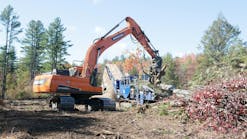Hurricane Sandy represented one of the largest-scale evacuations declared in recent history in the United States,” says Edward Schneyer, director of emergency preparedness with the Suffolk County (NY) Office of Emergency Management.
“During Sandy, we rescued 250 people from their flooded homes, evacuated two major hospitals and several adult homes,” says Schneyer.
He says he was able to do this effectively because his agency has storm surge maps created by the US Army Corps of Engineers, New York District. Storm surge is when a significant amount of water is pushed from the sea onto the land by a hurricane.
These maps provide emergency managers in all hurricane-prone states an understanding of the potential for the extent of storm surge that could occur for worst-case Category 1 to 4 storms, identifying areas from which people should evacuate if faced with the threat of storm surge.
Presently the Army Corps is updating these maps with higher-resolution modeling and topography performed by NOAA’S National Hurricane Center’s Storm Surge Unit, so agencies will have more accurate information to educate the public, thus reducing risk to themselves and their property.
“Historically, 49% of human causalities from hurricanes are due to storm surge,” says Donald E. Cresitello, USACE Hurricane Evacuation Study program manager for the State of New York, US Army Corps of Engineers, New York District. “Other impacts like riverine flooding due to rainfall, falling trees due to high winds, and indirect impacts like carbon monoxide poisoning and electrocution, can cause deaths.”
“The development of these maps is the first step in the hazard analysis for the hurricane evacuation study process,” says Cresitello.
This map, which shows a portion of the Connecticut shoreline, is an example of a storm surge map. The map shows the extent of surge that can be expected as a result of a worst-case combination of hurricane landfall location, forward speed, and direction for each hurricane category.
As the hurricane evacuation study managers for the National Hurricane Program, the Army Corps is responsible for creating these maps. The maps, which are officially named the “New York Hurricane Evacuation Study Hurricane Surge Inundation Maps,” are being produced in collaboration with the Army Corps’ New England and Baltimore Districts.
The Army Corps provides these maps to emergency managers in New York City, Westchester County, and Nassau and Suffolk Counties on Long Island, NY.
The Army Corps also guides emergency managers on how to use these maps by providing the maps in a hurricane decision-making software entitled HURREVAC (Hurricane Evacuation), developed by Sea Island Software for the National Hurricane Program.
Cresitello says, “Agency officials can use these maps to help reduce risk to the public. They can use them for evacuation planning, to redefine their hurricane evacuation zones, identify where shelters should be located, and identify where assets should be staged prior to impact from a storm.”
Schneyer says, “The storm maps serve as a very valuable resource for both government and private sector agencies, as well as private residents. As a government agency tasked with emergency management responsibilities pertaining to evacuation and sheltering of the public, we use the maps to gain insight and perspective into the geographical area impacted and use this information to determine the number of buildings or population potentially impacted by a flood.”
From this information his agency can also pre-identify damage assessments even before the storm impacts the region. Suffolk County, where Schneyer manages, has approximately 1,000 miles of shoreline, and its hurricane evacuation zones contain 225,000 residents.
The new maps, like previous ones, are being created using GIS (geographic information systems). GIS uses data from various sources, such as aerial photography, and combines these layers of information in various ways to perform analysis and create maps. (See the sidebar for additional information).
The new maps will be a considerable improvement from the older maps, because they will have higher-resolution storm surge modeling data and topography that will provide greater detail and accuracy. The new maps will show not only the extent of inland storm surge, but also the depth of the water—in ranges of feet—during different categories of storms.
In addition, the maps will illustrate areas that will experience more flooding and areas that will experience less flooding.
“Knowing what the depth of water may be in those areas helps emergency managers better perform their initial response after a storm and helps them know what kind of impacts they may expect during these types of storms,” says Cresitello.
As a result, emergency managers can better focus their limited resources. “As emergency managers dealing with the recovery effort and critical decision making, these storm maps provide the geographical area of primary concern where efforts and resources need to be focused to make essential and accurate damage assessments to determine life and property hazards,” says Schneyer.
“In the initial stages of a response our recovery resources are limited, especially for an event the size of Sandy. If resources are dispatched to areas that were not impacted, valuable time is lost mobilizing and reassigning those resources,” he says.
Using GIS to Create Higher-Resolution
Storm Surge Maps
GIS is being used to create the higher-resolution storm surge maps. It is a computer-based information system and tool capable of capturing, storing, analyzing, and displaying location information. GIS takes data from various sources such as aerial photography, and combines these layers of information in various ways to perform analysis and create maps.
To create the higher-resolution storm surge maps, higher-resolution storm surge elevation information from NOAA’s SLOSH model (Sea, Lake, Overland Surges from Hurricanes) is being layered over higher-resolution LiDAR-based topography—land elevation information—in the GIS program ArcGIS, which is used by the Army Corps.
“To come up with the actual depth of water through GIS, we are overlaying the data out of NOAA’s SLOSH model and subtracting out the ground elevations using digital elevation models and coming up with an actual depth of water in feet,” says Donald E. Cresitello, Hurricane Evacuation Study program manager for the State of New York, US Army Corps of Engineers, New York District.
These maps are a tool not just for agencies, but also for the general public. Schneyer says, “These maps provide an important level of awareness to residents that either live in a flood area or are preparing to purchase property located in a potential flood zone or hurricane storm surge zone.”
Storm surge in downtown New York City in the aftermath of Hurricane Sandy
Schneyer’s agency is bringing this awareness directly to its residents, taking the information from the Army Corps’ maps and entering it into an interactive mapping program developed and viewable on the county’s website.
Members of the public can visit the website to locate their residence, see if their home is in a hurricane storm surge zone, and if so, determine which designated shelter is nearby.
The Army Corps also wants the public to use these resources. “It’s important for people to know their specific zone,” says Cresitello. “The public should be aware of what evacuation zone they live in and should listen to their local officials, such as the mayor or emergency manager, so they don’t question or ignore an official emergency evacuation order.”
He adds, “We don’t want the public deciding on their own if they should evacuate or not. If a location is in danger then they should heed the evacuation order. It doesn’t matter if it’s 6 inches or 10 feet of water.”
During Sandy, people who should have evacuated but didn’t were stranded without help and faced many dangers, including electrocution from downed power lines and fires from massive gas leaks.
Schneyer says, “The more information, especially information resulting from scientific studies and available technology, the more situationally aware we and our residents will be. This very valuable resource is an excellent tool for public education, emergency management planning, and emergency preparedness in general.”















